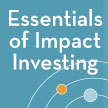Essentials of Impact Investing: A New Guide for Small-Staffed Foundations
Every foundation, regardless of size, can now effectively engage in impact investing. Working with our partners at Mission Investors Exchange and Exponent Philanthropy, we’ve written the book on how.
 Once an experimental practice, impact investing has begun to move squarely into the mainstream. A much wider range of investors is getting involved, even as those with years of experience are making increasingly sophisticated investments. As we have written before on this blog, this is a crucial time for the field. While much territory remains uncharted, the practice of impact investing has matured: infrastructure has been developed, best practices have emerged, and opportunities have multiplied. Now, every foundation can effectively engage in impact investing, putting new and different types of capital to work for social good.
Once an experimental practice, impact investing has begun to move squarely into the mainstream. A much wider range of investors is getting involved, even as those with years of experience are making increasingly sophisticated investments. As we have written before on this blog, this is a crucial time for the field. While much territory remains uncharted, the practice of impact investing has matured: infrastructure has been developed, best practices have emerged, and opportunities have multiplied. Now, every foundation can effectively engage in impact investing, putting new and different types of capital to work for social good.
To help make that happen, we’ve worked with our partners at Mission Investors Exchange and Exponent Philanthropy—as well as dozens of other practitioners and experts—to develop a new guide: Essentials of Impact Investing: A Guide for Small-Staffed Foundations.
Helping Smaller-Staffed Foundations Achieve Outsized Impact
The new guide covers the essentials of impact investing and will likely be of interest to anyone concerned with this topic. However, it focuses primarily on the needs and opportunities of smaller-staffed foundations. For more than 10 years, Arabella has supported such foundations, helping philanthropists efficiently manage their foundations, engage their families, drive impact through effective giving, and—increasingly—develop impact investing programs.
Based partly on that experience, Essentials of Impact Investing seeks to isolate and address the challenges smaller-staffed foundations often face when starting impact investing programs. Simply by virtue of having few (or no) staff members, such foundations have to overcome barriers that larger institutional foundations don’t. Yet smaller-staffed foundations also enjoy advantages over their more bulked-up brethren. Having fewer staff often means they have nimbler structures and can adapt more quickly and seize opportunities more readily. What’s more, small-staffed foundations often have specialized knowledge in particular geographic and/or program areas, and can use their unique knowledge and networks to identify potential investments and to attract additional investors.
One of the primary purposes behind our guide is to help smaller-staffed foundations get set up for success with impact investing—to overcome the challenges they face and to capitalize, in some cases literally, on the unique opportunities they enjoy.
A Guide to the Guide
Based on input from some of the leading investors and experts in the field, as well as our own and our partners’ experiences, Essentials of Impact Investing includes:
- Clear definitions of the myriad and sometimes confusing terms used in the impact investing field
- Over two dozen rich case examples of how peer foundations have approached impact investing, highlighting the investments they’ve made
- Practical tools and expert advice for conducting necessary due diligence, structuring investments, and building a monitoring plan (with measures of financial and social impact) into your portfolio from the outset
- and much, much more
We hope that this guide helps anyone who is starting or growing an impact investing practice to take the next step and be more successful by learning from others’ experiences. We welcome your feedback and look forward to many discussions about the issues laid out in the guide.
We and the other authors are also planning a series of virtual and in-person events, as well as blog posts, case studies, and more over the coming months. We invite you to download a copy below.
